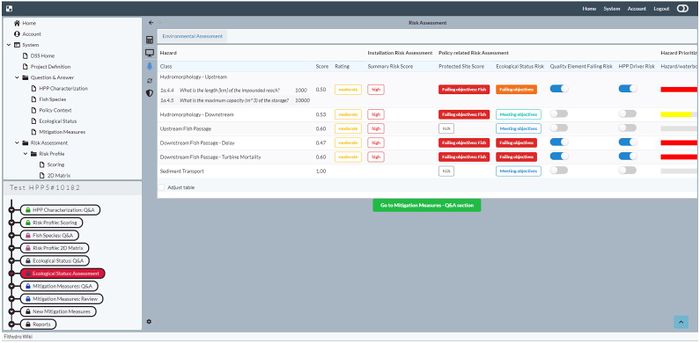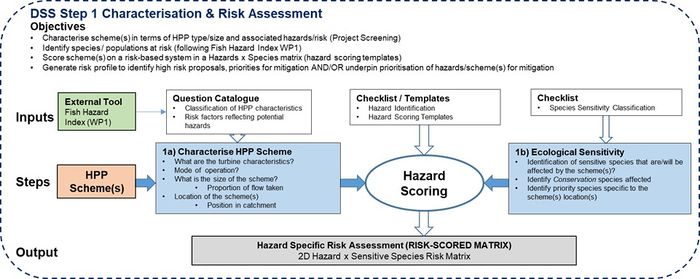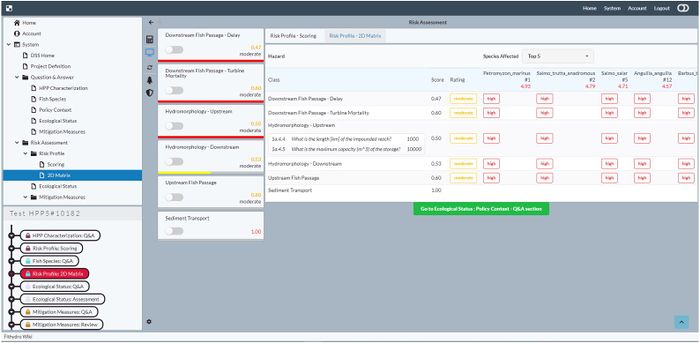Difference between revisions of "Decision Support System Steps"
Bendikhansen (talk | contribs) |
Bendikhansen (talk | contribs) |
||
| Line 11: | Line 11: | ||
[[file:DSS_step_1_SS.jpeg|thumb|700px|none|caption|FIThydro DSS Risk Profile – Hazard Scoring screen, indicating the identified hazard classes applicable to the HPP and the scoring template used for one of the hazard classes.]] | [[file:DSS_step_1_SS.jpeg|thumb|700px|none|caption|FIThydro DSS Risk Profile – Hazard Scoring screen, indicating the identified hazard classes applicable to the HPP and the scoring template used for one of the hazard classes.]] | ||
| + | |||
| + | =Step 2 - Ecological status assessment and review of existing mitigation= | ||
| + | ==Decision Framework== | ||
| + | The second step in the framework builds on the risk assessment pre-screening and determines the priorities for the scheme in relation to the ecological status and environmental/conservation objectives. This step provides a risk assessment for the ecological status of the waterbodies affected by the scheme/hazards and also reviews the presence and effectiveness of existing mitigation measures. The output of this step firstly is a prioritised list of hazards for the scheme(s) (with the scheme(s) scores based on the actual status of, and objectives for, the waterbodies affected). The second output is an evaluation of existing mitigation measures (against permitting/legislative requirements and understanding of specific effectiveness) to identify priority hazards for further mitigation and the specific measures that may need improving. | ||
| + | |||
| + | [[file:DSS_step_2.jpeg|thumb|700px|none|caption|Conceptual flow diagram of Step 2 of the proposed Decision Support System Framework – Ecological Pressures and Impacts Characterisation and Risk Identification. Grey = outputs/inputs to/from steps; blue = tasks; White = FIThydro inputs and matrices; Green = final output/objective.]] | ||
| + | |||
| + | ==Web-tool implementation== | ||
| + | In Step 2 a targeted questionnaire and scoring system is used to determine the status of the host waterbody for the scheme(s) according to the environmental policies that govern the scheme(s) and the evidence for known impacts on fish and waterbodies from national level assessments. The decision maker has to select status assessment categories from a pre-defined checklist for international directives and input data for national and regional regulations/legislations and associated assessments. The aim of this section is to determine the risk associated with a scheme in terms of causing a net deterioration in ecological/conservation status, and framing the scheme in terms of the objectives and legal requirements for mitigation. A number of metrics are presented to the user in a hazard matrix and a summary metric is calculated as the sum of the protected site score and the ecological status scores. This summary score is used as a prioritisation metric to rank the hazards in the hazard summary screen and also used to order the hazards in order of requiring mitigation. | ||
| + | |||
| + | [[file:DSS_step_2_SS.jpeg|thumb|700px|none|caption|FIThydro DSS ecological status risk matrix identifying the calculated Protect Site Score, Ecological Status Risk Score and indicating whether priority quality elements (fish, hydromorphology, continuity) are identified as a reason for failing the objectives and whether the HPP has been identified in river basin management plans to be significantly contributing to a failure to achieve good ecological status. These components are combined into the Hazard/waterbody priority score metric.]] | ||
Revision as of 11:43, 27 October 2020
See Decision support system for general information about the DSS.
Contents
Step 1 - HPP Characterization & Risk Identification
Decision Framework
The objective of the first step of the planning and decision framework is to characterize the HPP (existing or proposed) in terms of its design (general layout, scale, turbine type, mode of operation), then identify and score the inherent risks posed by the type and size of scheme in relation to its context. There are three tasks in this process, the first task characterizes the HPP in terms of its location, design and operation, the second task is to identify the species/populations at risk and the third task is to identify and risk assess the key hazards associated with the scheme.
Web-tool implementation
Step 1 in the tool comprises a questionnaire and hazard-scoring template to identify the key hazards posed by a specific HPP and the species of fish likely to be affected. The FIThydro DSS tool identifies the risk posed by a hazard as the combination of the hazard score (the nature and effect of the hazard) in combination with the sensitivity of the species that are affected. As such the risk scoring of a hazard is completed within a 2D matrix to determine the risk profile and assign summary risk classes to each relevant hazard. The risk score for each hazard and species combination is determined using a cross-tab lookup table from the Hazard risk class (named the hazard rating) and species sensitivity class (sensitivity to additional mortality caused by hydropower).
Step 2 - Ecological status assessment and review of existing mitigation
Decision Framework
The second step in the framework builds on the risk assessment pre-screening and determines the priorities for the scheme in relation to the ecological status and environmental/conservation objectives. This step provides a risk assessment for the ecological status of the waterbodies affected by the scheme/hazards and also reviews the presence and effectiveness of existing mitigation measures. The output of this step firstly is a prioritised list of hazards for the scheme(s) (with the scheme(s) scores based on the actual status of, and objectives for, the waterbodies affected). The second output is an evaluation of existing mitigation measures (against permitting/legislative requirements and understanding of specific effectiveness) to identify priority hazards for further mitigation and the specific measures that may need improving.
Web-tool implementation
In Step 2 a targeted questionnaire and scoring system is used to determine the status of the host waterbody for the scheme(s) according to the environmental policies that govern the scheme(s) and the evidence for known impacts on fish and waterbodies from national level assessments. The decision maker has to select status assessment categories from a pre-defined checklist for international directives and input data for national and regional regulations/legislations and associated assessments. The aim of this section is to determine the risk associated with a scheme in terms of causing a net deterioration in ecological/conservation status, and framing the scheme in terms of the objectives and legal requirements for mitigation. A number of metrics are presented to the user in a hazard matrix and a summary metric is calculated as the sum of the protected site score and the ecological status scores. This summary score is used as a prioritisation metric to rank the hazards in the hazard summary screen and also used to order the hazards in order of requiring mitigation.



